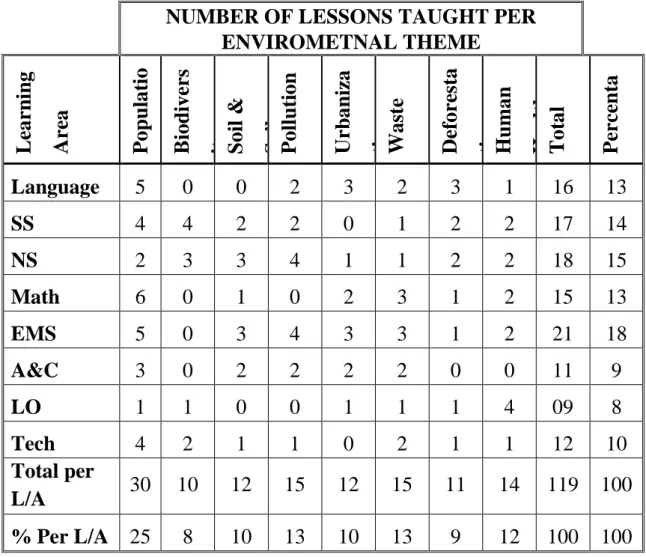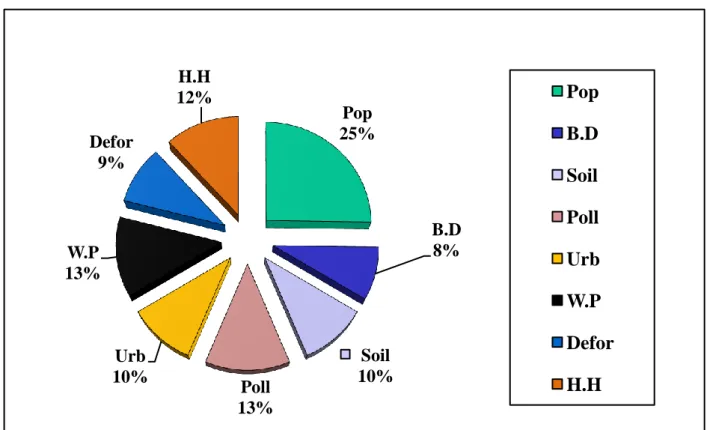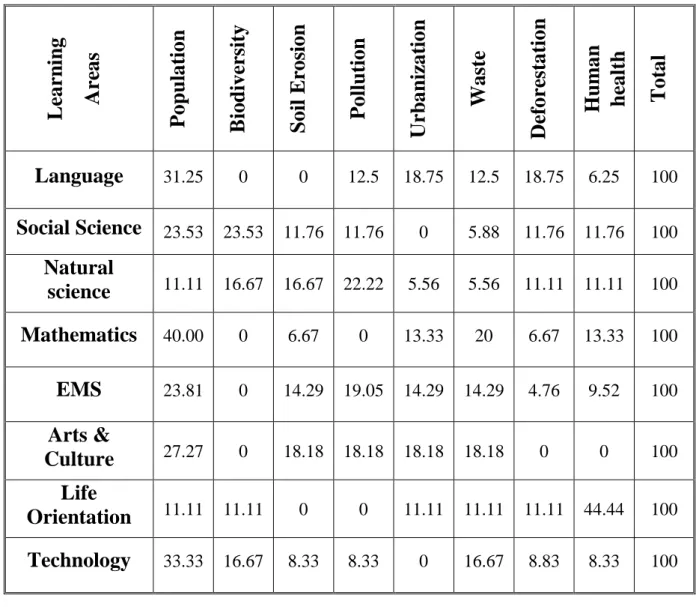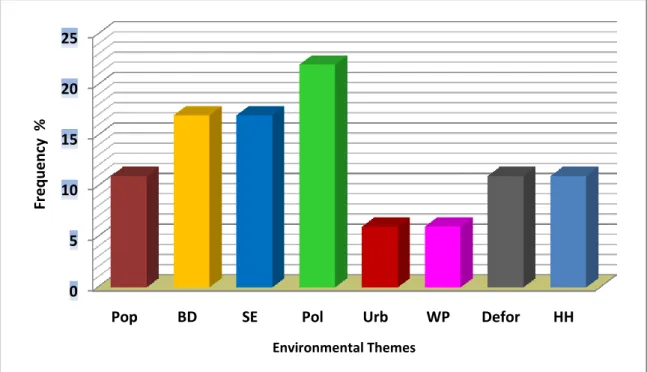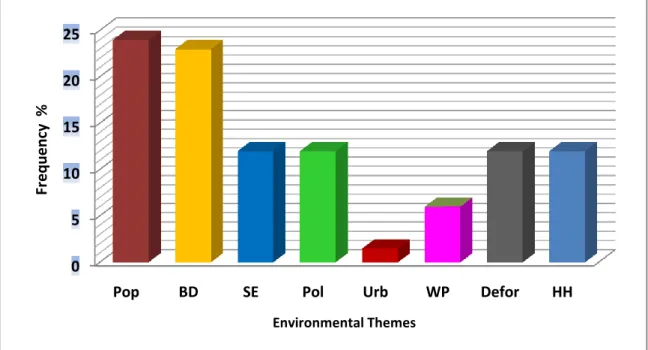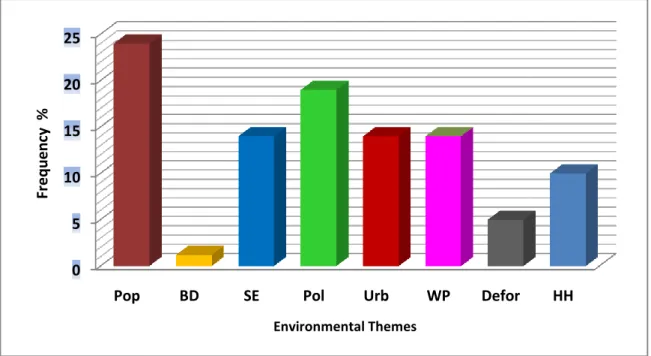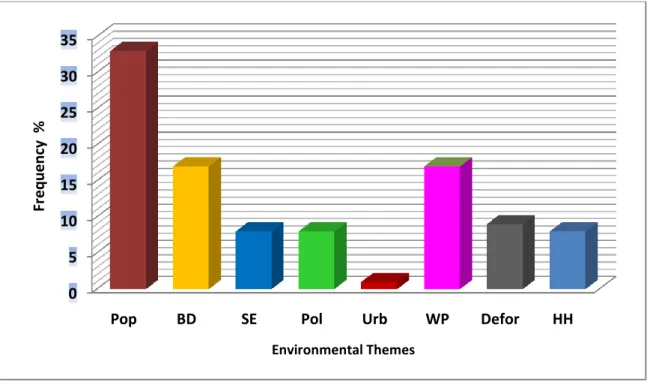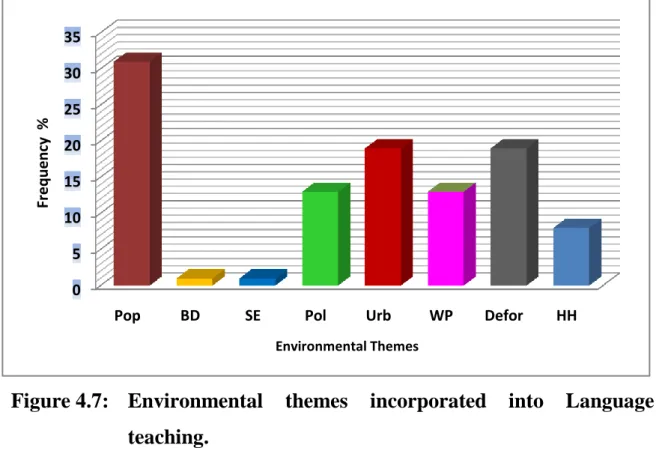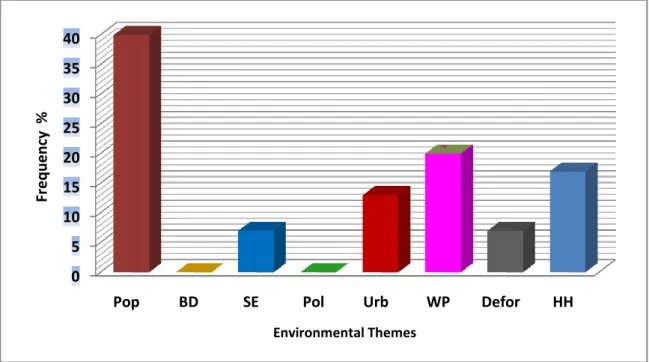The study was to find out why some environmental topics were more interesting to learn compared to others. The constructed objectives of the research study lead to the formulation of the following research hypotheses: (a) The frequency with which the identified environmental topics are taught varies in relation to different learning areas;. b) Some identified environmental topics are more interesting to learn compared to others; and (c) Educators use a variety of teaching methods when teaching environmental education at the senior stage.
INTRODUCTION
MOTIVATION FOR THE STUDY
Educators who teach different subject areas are tasked with ensuring that the particular subject area/subject plays a role in the work and life of citizens in South African society – particularly in relation to human rights and environmental policy (Palmer & Neal , 1995). For example, one of the critical outcomes in the GET band states that it envisages learners who are able to demonstrate an understanding of the world as a set of interconnected systems by recognizing that problem-solving contexts do not exist in isolation [RNCS Review Policy Document (ratings R.
STATEMENT OF THE PROBLEM
However, there are a number of questions in terms of educators' readiness to integrate OO in all learning areas, including the question: Are all educators aware that OO must be integrated in all learning areas. The role of the teacher as curriculum designer, interpreter and implementer cannot be overemphasized in this study.
THE PURPOSE OF THE STUDY
The research also sought to find out which methods are often used by educators in teaching EE in their specific learning areas. How often are environmental themes identified and taught in different learning areas in the senior phase?
DEFINITION OF MAJOR CONCEPTS
These questions represent the core intent or objectives of this research study, which sought to examine whether Senior Phase educators implemented Environmental Education (EE) teaching in their areas of learning. The size of the research sample has implications for the outcomes of the research study.
DELIMITATION OF THE STUDY
Other possible topics that could have been included in the study are: global warming, alien and indigenous species, wetlands, marine life and conservation, which could have contributed to a better understanding of the Environmental Education issues under investigation.
SIGNIFICANCE OF THE STUDY
It is hoped that students' interest in EE topics will be stimulated through learning that includes practical and intellectual activities. As learners belong to communities, it is assumed that the wider community would benefit over time from learners' knowledge, attitudes and awareness.
ORGANISATION OF THE STUDY
In this chapter, the collected data is analyzed and interpreted and some conclusions are drawn from the outcomes. According to the analysis and interpretation of data, this chapter draws some conclusions from the findings of analysis, and provides appropriate recommendations for action that can be taken in future research.
CONCLUSION
Overall, answers were provided to questions that were posed, such as: How often are environmental themes taught in different learning areas in the senior phase. It can be seen as the fountain of discovery ready to provide answers and basis for initiating change in the South African education scenario.
INTRODUCTION
ENVIRONMENTAL EDUCATION IN OUTCOMES BASED EDUCATION
Schools in South Africa must ensure that they produce learners who are environmentally literate and proactive. The Technology learning outcome 3 states or gives the connection between technology society and the environment (HNKV, 2003i).
EDUCATORS IN THE TEACHING OF EE THROUGH OBE
Ketlohilwe (2003) argues that educators in South African schools should design curricula that address community-related issues such as human rights, life skills, HIV/AIDS, violence, drug abuse and poverty. Some of these competencies for educators mention the role of the teacher in relation to the environment (EECI, 2000). Educators in South African education systems are expected to take these roles into consideration when designing outcome-based learning programs for integrating EE into the mainstream curriculum.
Given the challenges that educators face in the implementation of Outcomes Based Education (Mattson & Harley, 2003) assert that outcomes-based education requires a high level of discipline, knowledge and expertise on the part of teachers and is seen as a view extended. of professionalism.
Robottom (1993:18) cites a lack of understanding of environmental education processes and a lack of capacity to implement EE on the part of teachers as a challenge. The then Minister of State for Education of South Africa, Naledi Pandor, in her speech at the National Colloquium on the Environmental Education Project, appreciated the contribution of NEEP-GET in the professional development of teachers and curriculum consultants to promote the successful implementation of EE in the GET belt [ http://www.policy. org.za/article/pandor_coll. The preceding discussion shows that environmental education initiatives can play an important role if implemented consistently and continuously.
Palmer (1998) argues that even where well-designed and successful environmental education programs exist, their impact on long-term thinking and behavior is not as great as that of other significant experiences and formative influences in people's lives.
Influencing long-term thinking and action in students' lives can be possible if educators use appropriate teaching methods. Therefore, it is essential that educators choose teaching methods that cater for a variety of learner-centered activities. Teaching methods can be linked to ideologies related to EE teaching, namely teaching through/in, about and about the environment.
The teaching methods associated with this learner-centered approach are solitaire, encounter, dialogue, discussion, and reflection.
ENVIRONMENTAL EDUCATION IN OTHER SOUTHERN AFRICAN COUNTRIES
Hungerford & Volk (1990), report that current environmental education in public school curricula can often be characterized by loose organization and little sense of direction. Clacherty (1989), points out that school curricula are already filled to the brim and the inclusion of environmental education as a subject should be completely excluded. The idea that environmental education in school curricula can often be characterized by poor organization and little sense of direction does not prevent public schools in all parts of the world from implementing EE in their teaching.
ENVIRONMENTAL EDUCATION IN INTERNATIONAL SOCIETIES
SUMMARY
INTRODUCTION
According to Babbie, Mouton, Payze, Vorster, Boshoff, &. 2000) the survey research technique is the best tool for the social researcher interested in collecting original data for describing a population too large to observe directly.
RESEARCH APPROACH
For reasons of confidentiality, female educators did not have to state their names or the names of schools in the questionnaire. All respondents could read and write and were familiar with the questions asked in the questionnaire. In the questionnaire, each respondent had to indicate their answers, therefore the questionnaire contained open-ended questions.
This section has not been analysed, but can be used to make recommendations to the department officials on the implementation of OO in the senior phase.
ETHICAL ISSUES
Responses to each questionnaire were coded to facilitate data analysis and interpretation. The research followed a descriptive method by describing whether educators in the Higher Stage implement EE in their specific learning areas. The analyzed data were used to describe in which curricular area EE was more or less integrated.
The analyzed data would alert higher level educators to the emphasis on EE teaching in the RNCS and thus improve their engagement in this aspect. a) Head of Education, Management: Obuka Ward (Annex 1).
TRUSTWORTHINESS
SUMMARY
The method used must be seen as a chain, and each link is crucial to achieving the research goal. The research methodology used in this study has helped to reveal how the research was designed to achieve the valid results. The design was also ensured through establishing acceptable ethical standards and levels of credibility and validity of the research findings.
The next chapter deals with the analysis and interpretation of the actual data described in this very section.
INTRODUCTION
THE TEACHING OF ENVIRONMENTAL THEMES
In this section, it was necessary to find out how the environmental themes shown in figure 4.3 relate to the natural science learning area. The analysis of results as shown in Figure 4.3 shows that all environmental themes had been taught in the science classes. In this section we seek to find out how environmental themes [Figure 4.4] relate to the social sciences.
Biodiversity and Soil and Soil Science environmental themes were not taught in any language lessons.
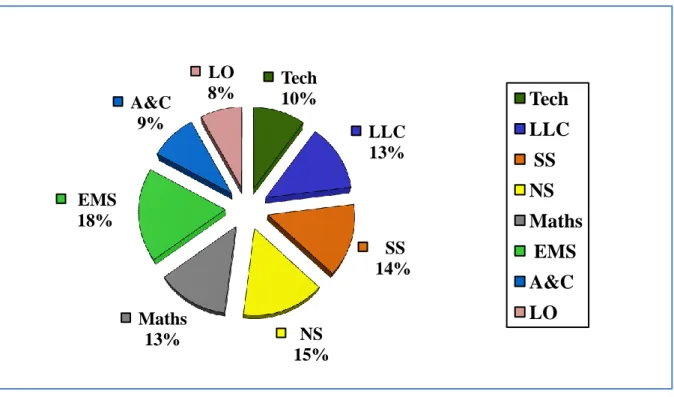
ENVIRONMENTAL THEMES THAT ARE INTERESTING TO TEACH
Waste and pesticides and deforestation seemed to be the least interesting to teach in contrast to population and human health.
METHODS USED IN TEACHING ENVIRONMENTAL THEMES
SUMMARY
INTRODUCTION
This chapter therefore provides a summary of the findings and related recommendations regarding the results of the research study.
GENERAL CONCLUSIONS
The main findings of the study were that educators at the senior stage implement EE in their learning areas through the use of RNCS documents. Educators involved in the study could identify those environmental topics that were increasingly less interesting to learn and the reasons why. Some of the educators in the study could not use other environmental topics because they assumed they were not relevant to their learning areas even though there was good content for their learning areas.
The study shows that the teachers in the research made efforts to integrate EE into their teaching areas, that their South African and international colleagues were also involved in the same process (Ketlhilwe, 2003).
SUMMARY AND RECOMMENDATIONS
Environmental themes such as deforestation and soil erosion were also identified as irrelevant to most learning areas. It is recommended that educators are encouraged to enroll in some specialist qualification in EE-related themes associated with more difficult and less mundane learning areas. In an effort to shape individuals with regard to EE, educators should be well trained and higher education institutions should recognize the pedagogical (methodological) and knowledge implications associated with the resolution of EE issues.
The educators should be empowered by getting them involved in EE-related activities and environmental issues of a practical nature in local schools.
CONCLUSION
That South Africa, as part of SADC, must be encouraged to establish contact with or collaborate with SADC countries on the teaching of environmental education using the cross-cutting themes at all levels of education, as is already practiced in other countries. Furthermore, through analysis and interpretation of goals given in chapter four, the chapter has attempted to address the more practical recommendations associated with integrating environmental education into the learning areas, by transforming the teaching process. Teaching and learning strategies for environmental education 1. Learning to teach for a sustainable world: Two Asia-Pacific projects in environmental education for teacher education.
Makhoba, a student at the University of Zululand in the Ministry of Education, wants to apply for permission to conduct research in some schools in Obuka schools.
Grades 2 topics covered
ENVIRONMENTAL THEMES OF LEARNERS’ INTEREST
ON WHICH THREE of the EIGHT ENVIRONMENTAL THEMES DO YOU NEED MORE DEVELOPMENT?
